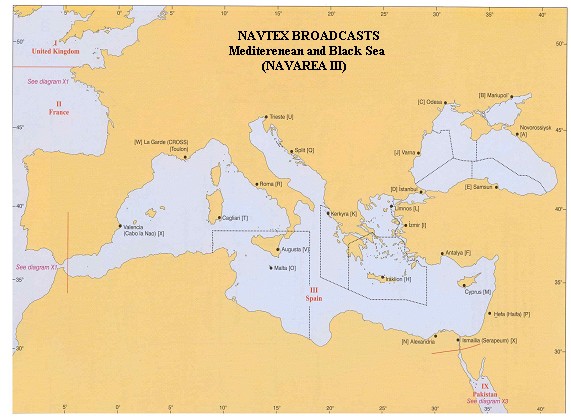NAVTEX (Introduction)
NAVTEX is an international automated direct-printing service that promulgates navigational and meteorological warnings as well as urgent information to vessels.
It has been developed to provide low cost maritime safety information and other information of vital importance.
Its name results from the term ‘navigation telex’.
NAVTEX system is recommended to administrations responsible for maritime affairs and to mariners who need an effective safety information maritime service.
NAVTEX service uses a frequency (518 KHZ) from which coast stations transmit information into English on a time-sharing basis to reduce the risk of mutual interference.4990 KHZ and 4290,5 KHZ frequencies are used for transmissions in national languages.
frequencies are used for transmissions in national languages.
NAVTEX STATIONS – NAVAREA III
Since 1988, three (3) NAVTEX stations were established and are still operating in the Hellenic sea room:
• Iraklion [H]
• Limnos [L]
• Kerkyra [K]
These stations transmit for six (6) hours in a daily basis every four hours. Coordinator of the transmissions is the Hydrographic Service which, for this purpose, collaborates with the Ministry of Mercantile Marine and the Hellenic National Meteorological Service.
The sea room of the Aegean and the Ionian sea belongs to Navarea III which also comprehends Mediterranean and Black Sea. The coordinator of Navarea III is the Spanish Hydrographic Service.
NAVTEX MESSAGE FORMAT
The NAVTEX message format is:
• ZCZC- B1B2B3B4
• Date- UTC Time- Month- Year (261630UTC MAY 2002)
• Number of message from the beginning to the end
• Text of the message
• NNNN
• ZCZC: Indicates the beginning of a message
• B1: Indicates the type of the station (letters from A to Z)
• B2: Indicates the type of the signal (letters from A to Z)
• B3B4: Indicates the number of the signal from 01- to 99 (except from special occasions where the serial number is 00 indicating search and rescue signals.
SELECTIONS- TRANSMISSION TIME- RANGE
• The receivers have the ability to select the station and the category of the messages. Independently from their selection, in cases of vital information (SAR), indicated as B2- D and B3B4- 00, the receiver is automatically stimulated.
• The time of the Transmission of the NAVTEX stations is at maximum ten (10) minutes. Breaking this time limit is prohibited because after the first station’s end of Transmission the Transmission of another station starts.
• The range of the NAVTEX stations mainly depends on their position but, in any case, does not exceeds 400m.
APPLICATION
The G.M.D.S.S applies to:
• Vessels subjected to the SOLAS convention
• Passenger ships of 24 meters and above, engaged on domestic voyages
• All fishing boats of 24 meters and above
• All fishing boats, regardless of their length, that sail for more than ten nautical miles far from the shore.

